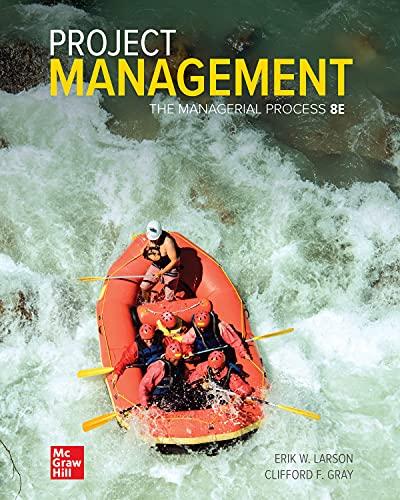Shell Case Fabricators (SCF) designs and builds shell casings that enclose electronic products such as calculators, cell
Question:
Shell Case Fabricators (SCF) designs and builds shell casings that enclose electronic products such as calculators, cell phones, and modems. Typically the cases are plastic or plastic compounds. SCF has six different production lines that cover different types of product. For example, the largest high-volume production line for modems can produce three different colors and two models (vertical and flat). Air Connection Links (ACL) is the biggest customer that buys product from this line. This high-output line now runs at full capacity on an eight-hour shift. The other five lines run smaller quantities and tend to meet the needs of other specialty products manufactured by different, smaller firms.
Ninety-five percent of SCF’s product casings line is designed by the original hardware manufacturer. Getting a casing to the production stage requires a great deal of collaboration and interaction between the original hardware and case design manufacturer (e.g., ACL) and SCF’s shell design engineers and Production Department. The latest new product of ACL is a modem designed to be used for monitoring water activity in bays, such as ship traffic, pollution, and floating debris. Because of the product’s high functionality and low cost, potential demand for the new product is out of sight. It seems every country with small bays used for shipping wants enough underwater modems to cover its respective bays.
At SCF each new product is assigned a project manager to coordinate and manage the shell design, budgets, and manufacturing start-up. Songsee is SCF’s star project manager and is the project manager of the shell for the new short-range, underwater acoustical modem. The shell casing for the underwater modem required special design and materials, custom equipment, and a seal to withstand pressure to 50 meters. Air Connection Links, the product owner, needs 60,000 modems in 91 days (next January 15) for the Estuary Control Institute meeting in Hong Kong.
Songsee has felt the project was moving along smoothly, with the exception of being two weeks behind schedule. She feels she can “lean on” the Design Department to put the project on top priority and make up the two weeks. Yesterday ACL’s project manager, Sabin, came in with a “simple change”: change the outer shell shape from rectangular to dome shape; it will improve performance 2 percent. Songsee couldn’t believe Sabin. He knows better. He knows the engineering implications, and it is NOT simple! Yet Sabin tells Songsee, “It shouldn’t cost much.” Songsee imagined a sharp retort, but she counted to five and aborted. At this late stage of the game, changes and schedule compression cost big money! Songsee said she would get together with her team and start on a new time and cost estimate that day. She told Sabin he would have to give her a written change request of the new requirements by the next day. Sabin appeared disappointed: “Why don’t we just add €100,000 to the price and get on with it? We have been doing business with SCF for six years. With expected demand out of sight, SCF will break even quickly and have a great profit on the production side.” Songsee sighed. “Let’s proceed with the change order process. I will take your request to the change order governance committee.”
Songsee’s meeting with her team about the change went about as expected. Every department moaned about changing at this late date. The guesstimate cost and time estimates were over triple Sabin’s idea of €100,000. For example, designing a new seal for a domestyle modem will require a new custom water sealing approach, possibly an untested different sealant, and new molds. Has ACL frozen the design of the new style modem? Songsee asked the team to come in with a more detailed estimate by tomorrow afternoon, before her meeting with the change order governance committee.
Sabin called from ACL at midmorning the next day: “Our senior management is upset that we have to be so formal for such a small change. They just want to get on with the project and meet the time-to-market launch date. €100,000 seems like a fair price. They believe you need to talk to your management. They want a response by Monday.”
The team estimates came close to yesterday’s guesstimate (€391,000)—not good news. Songsee knew the answer of the change committee would be to hold for the full amount. She was right. The change committee believed the costs are there and need to be covered to meet the launch date. The committee was also concerned that priorities and resource scheduling would have to change for SCF’s Design and Production Departments. In three hours she would meet with senior management to decide to accept the client’s request at their price or come up with an alternate plan. Songsee realized she should have several options for senior management to consider, along with a recommendation.
1. Should SCF accept or reject ACL’s request? Which option would you select? What risks are involved?
2. How should SCF negotiate with ACL? How can SCF and ACL develop a positive, longrange relationship? Give some specifics.
Step by Step Answer:

Project Management The Managerial Process
ISBN: 9781260570434
8th Edition
Authors: Eric W Larson, Clifford F. Gray





